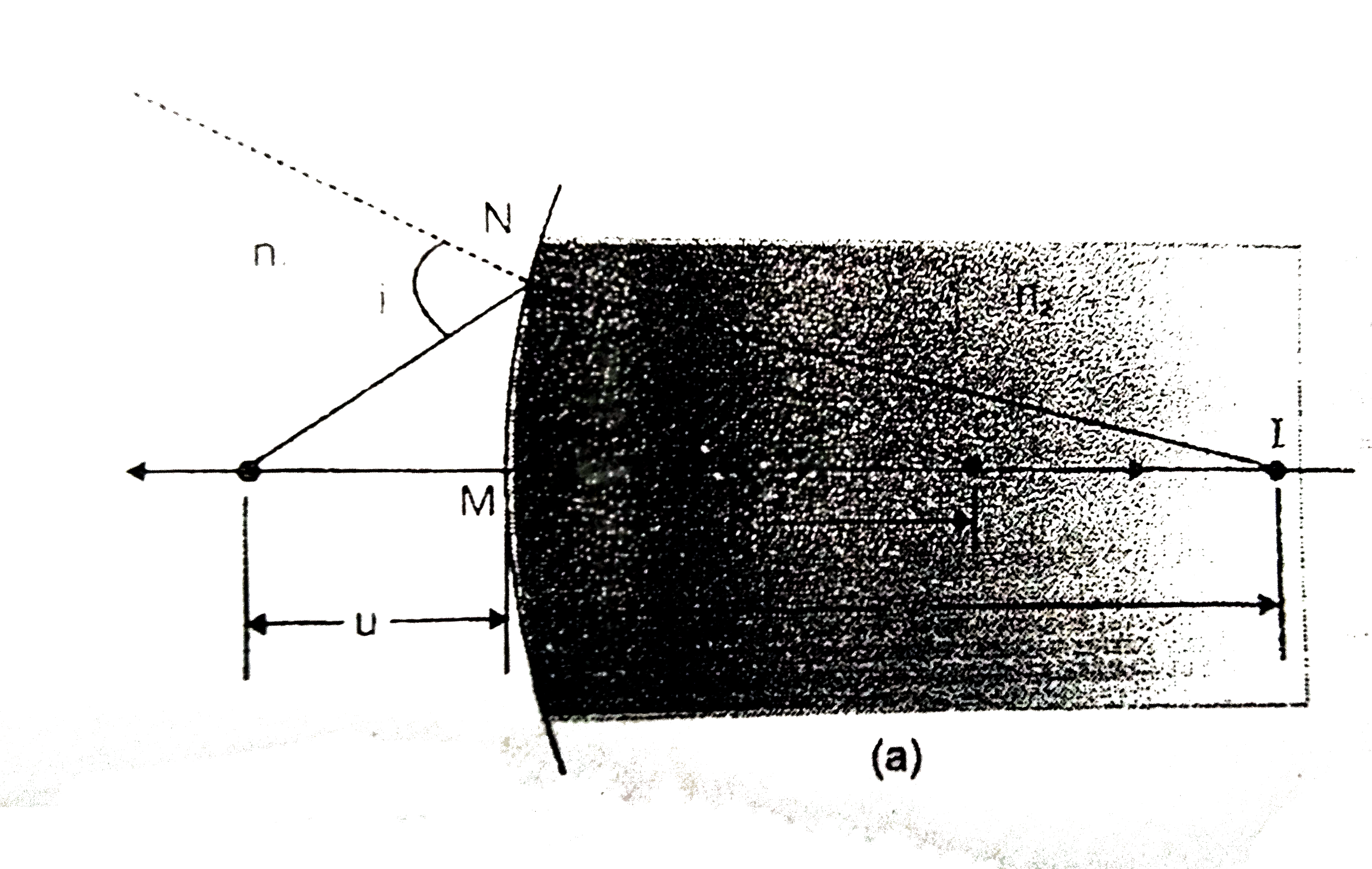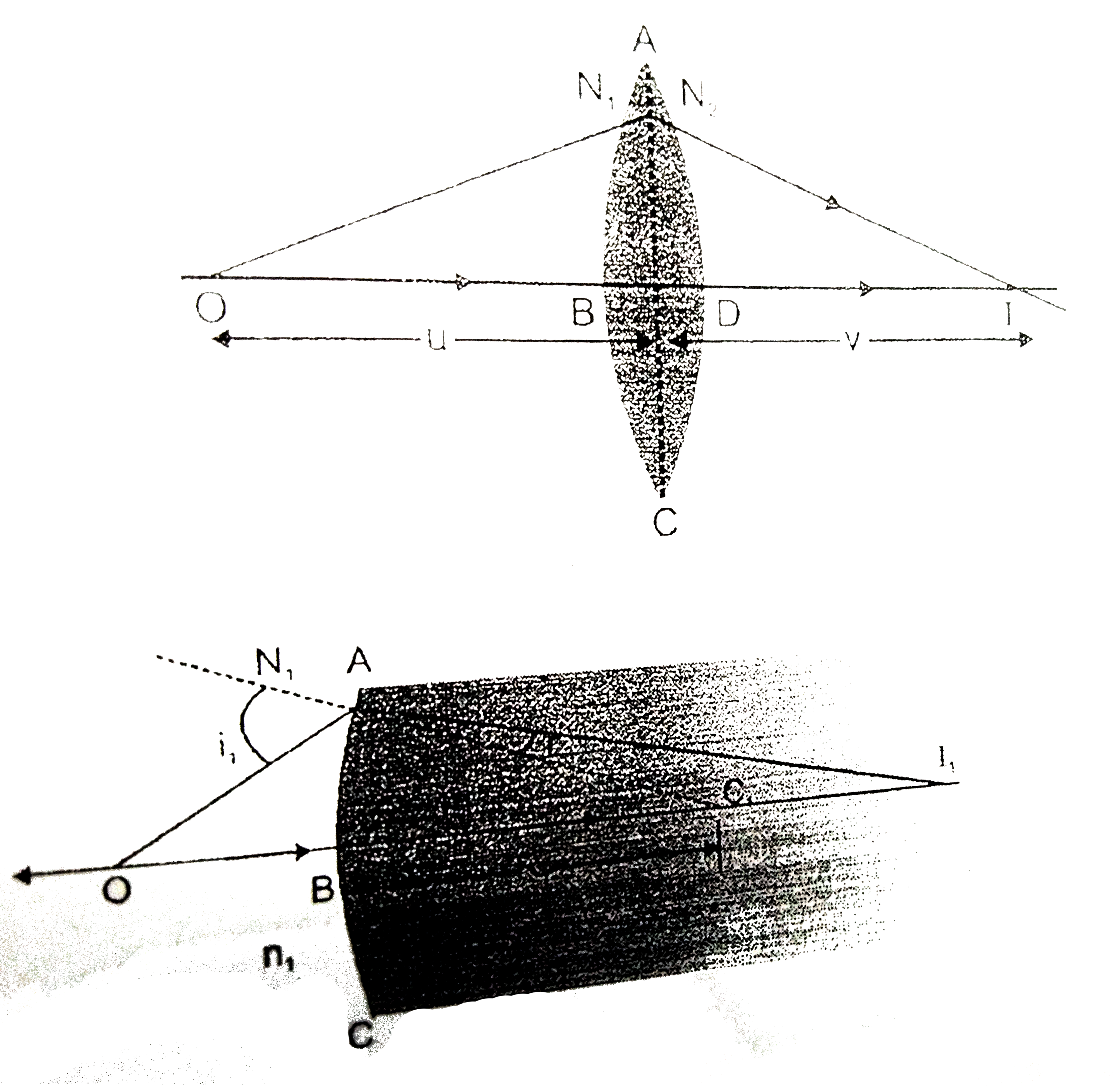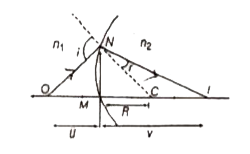(a) Draw the ray diagram showing the geometry of formation of the image of a point object situated on the principal axis, and on the convex side, of a spherical of radius of curvature R . Taking the rays as incident from a medium of refractive index n1 to anothr of refractive index n2 show that n2v−n1u=n2−n1R where the symbols have their usual meaning.
(b) Use this relation to obtain the (thin) lens maker's formula.
Refraction of spherical surface :
(a) Sign conventions : (i) All distances are measured from the pole of the spherical surface.
(ii) Distances measured in the direction of incident light are taken positive.
(iii) Distances measured in the opposite direction of incident light are negative.
Assumptions : (i) The object is a point object placed on the principal axis.
(ii) Aperture of the refracting surface is small.
(iii) Angle of incidence and angle of refraction are small
Figure (a) shows the geometry of formation of image I of an object O on the principal axis of a spherical surface with centre of curvature C, and radius of curvature R. The rays are incident from a medium of refractive index n1, to another of refractive index n2. As before, we take the aperture (or the lateral size) of the surface to be small compared to other distances involved, so that small angle approximation can be made. In particular, NM will be taken to be nearly equal to the length of the perpendicular from the point N on the principal axis. We have, for small angles,
tan∠NOM=MNOM
tan∠NCM=MNMC
tan∠NLM=MNMI
Now, for ΔNOC, I is the exterior angle.
Therefore, i=∠NOM+∠NCM
i=MNOM+MNMC
similarly
r=∠NCM−∠NLM
i.e.r=MNMC−MNMI
Now, by Snell's law
n1sini=n2sinr
or for small angles
n1i=n2r
Substituting i and r from Eqs we get
n1OM+n2MI=m2−n1MC
Here, OM,MI and and MC represent magnitudes of distances. Applying the cartesian convention, substuting sign convention,
OM=−μ,MI=+v,MC=+R
substituting these in Eq. we get,
n2v−n1u=n2−n1R
Equation gives us a relation between object image distance in terms of refractive index of the medium and the radius of cuvature of the curved spherical, It holds for any curved spherical surface.

(b) Lens Maker's Formula :
The first refractive surface forms the image I1 of object O. The image I1 acts as a virtual object for the second surface that forms the image at I [Fig.(b)]. Applying to the first interface ABC, we get
n1OB+n1DI=n2−n1DC21......(i)
A similar procedure applied to the second interface ADC gives,
−n2DI1+n1DI=n2−n1DC2.........(ii)
For a thin lens, BI1=DI1.
Adding Eqs. (i) and (ii), we get
n1OB+n1DI=(n2)(1BC1+1DC2)
Suppose the object is at infinity,
i.e.,OB→∞ and DI=f, Eq. (ii) gives

n1f=(n2−n1)(1BC1+1DC2).........(iii)
The point where image of an object placed at infinity is formula is called the focus F, of the lens and the distance f given its focal length. A lens has two foci, F and F', on either side of it . By the sign convention, BC1=+R1
DC2=−R2
So Eq. (iii) can be written as
1f=(n21−1)(1R1−1R2)............(iv) (n21=n2n1)
Equation (iv) is known as the lens maker's formula. It is useful to design lenses of desired focal length using surfaces of sutable radii of curvature. Note that the formula is true for a concave lens also. In that case R1 is negative, R2 positive and therefore, f is negative.

Topper's Solved these Questions
- GEOMATRICAL OPTICS BOOK - RESONANCECHAPTER - GEOMATRICAL OPTICS EXERCISE - Advance level Problems
35 Videos
- GEOMATRICAL OPTICS BOOK - RESONANCECHAPTER - GEOMATRICAL OPTICS EXERCISE - Exercise-2
63 Videos
- EXPERIMENTAL PHYSICSBOOK - RESONANCECHAPTER - EXPERIMENTAL PHYSICSEXERCISE - PART -II
10 Videos
- GRAVITATIONBOOK - RESONANCECHAPTER - GRAVITATIONEXERCISE - HIGH LEVEL PROBLEMS
16 Videos
Similar Questions
Show that nPr=n−1Pr+r,n−1Pr−1 Where the symbols have their usual meanings.
View SolutionA biconvex thin lens is prepared from glass of refractive index μ2=32. The two conducting surfaces have equal radii of 20 cm each. One of the the surface is silvered from outside to make it reflecting. It is placed in a medium of refractive index μ1=53. It acts as a
View Solution
Knowledge Check
Light travels from medium 1 (refractive index = n1) to medium 2 (refractive index = n2 ). If it is found that deviation d=r-i. We can say that
An1=n2Bn1<n2Cn1>n2Dnone of theseA ray of light travels from a medium of refractive index n1 to
a medium of refractive index n2. If angle of incidence is i and
angle of refraction is r, than sinisinr is equal toAa n1Bb n2Cc n2n1Dd n1n2When a lens of refractive index n1 is placed in a liquid of refractive index n2, the lens looks to be disappeared only if
An1=n22Bn1=34n2Cn1=n2Dn1=54n2
A point object 'O' on the principal axis of a spherical surface of radius of curvature 'R' separating two media of refractive indices n1andn2 forms an image 'I' as shown in the figure below. Prove that n2v−n1v=n2−n1R

View SolutionDraw a ray diagram to show the formation of the real image of a point object due to a convex spherical refracting surface, when the ray of light is travelling from a rarer medium of refractive index nx to a denser medium of refractive index n2 .
Using this diagram derive the relation between object distance (w), image distance (v), radius of curvature (R) of a convex spherical surface. State the sign convention and the assumptions used.
View SolutionParallel rays of light are falling on convex sphere surface of radius of curvature R = 20 cm as show. Refractive index of the medium is μ=1.5. A refraction from the spherical surface parallel rays

View SolutionA ray of light goes from a medium of refractive index n1 to a medium of refractive index n2. The angle of incidence is I and the angle of refraction is r. Then, sin i/sin r is equal to
View SolutionParallel rays of light are falling on convex sphere surface of radius of curvature R = 20 cm as show. Refractive index of the medium is μ=1.5. A refraction from the spherical surface parallel rays

View Solution
